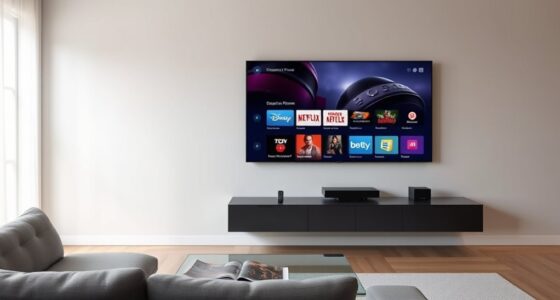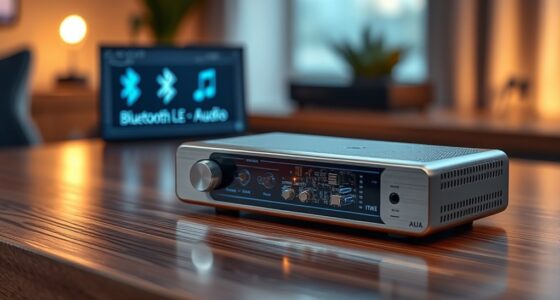Choosing between rechargeable and disposable batteries for your hearing aids depends on your priorities. Rechargeable batteries are more eco-friendly, saving you money over time and reducing waste, while disposable ones are convenient for quick replacements. Although rechargeable options may have higher upfront costs, they last longer and are simpler to manage daily. If you want to understand how these choices compare in detail, you’ll find helpful insights ahead.
Key Takeaways
- Rechargeable batteries are more environmentally friendly, reducing waste and pollution compared to disposable zinc-air batteries.
- Although initially more expensive, rechargeable hearing aid batteries save money over time due to their reusability.
- Rechargeable batteries offer greater convenience, allowing users to recharge overnight without carrying spare batteries.
- Advances in technology have improved the lifespan and efficiency of rechargeable batteries, making them a reliable option.
- Disposable batteries are cheaper upfront but require frequent replacement, leading to higher long-term costs and waste.

When choosing batteries for your hearing aids, understanding the differences between rechargeable and disposable options can considerably influence your daily experience. One of the first considerations is the environmental impact. Disposable batteries, typically zinc-air type, generate a substantial amount of waste because you throw them away after each use. Over time, this contributes to environmental pollution, especially if you don’t recycle properly. In contrast, rechargeable batteries are designed to last for years, reducing the number of batteries that end up in landfills. They can be reused hundreds of times, which means fewer resources are consumed in manufacturing and less waste accumulates. If environmental consciousness matters to you, opting for rechargeable batteries aligns better with sustainable practices, especially since many manufacturers now promote recycling programs for these batteries to further minimize ecological footprints. Additionally, the development of battery technology continues to improve the efficiency and lifespan of rechargeable options, making them an increasingly attractive choice for users seeking sustainable solutions.
Cost comparison is another critical factor that influences your decision. Disposable batteries might seem cheaper upfront—often costing a few dollars for a pack—but their ongoing expense adds up over time. You need to replace them regularly, sometimes weekly, depending on usage and the type of hearing aid. This continual cost can become substantial over months and years. Rechargeable batteries, on the other hand, typically involve a higher initial investment because of the price of the batteries themselves and the charger. However, since they can be recharged multiple times, your long-term expenses decrease noticeably. You’ll spend less on replacements and save money over the lifespan of your hearing aids. Keep in mind that some rechargeable batteries require replacement after several years, but even then, the cost advantage usually favors reusability.
Beyond environmental impact and cost, convenience also plays a role. Disposable batteries demand you to carry spares and remember to replace them regularly, which can be inconvenient if you’re busy or forgetful. Rechargeable batteries, especially with built-in charging docks or cases, offer the convenience of simply plugging in your hearing aids overnight or during daily routines. This ensures they’re always ready to go without the worry of running out of power at inconvenient times.
Frequently Asked Questions
How Do Rechargeable Batteries Impact Hearing Aid Maintenance?
Rechargeable batteries make hearing aid maintenance easier by reducing the need for frequent battery changes. You’ll benefit from a longer battery lifespan and simpler routines, since you just need to keep the device charged regularly. This minimizes daily maintenance tasks, and you won’t worry about running out of power unexpectedly. Overall, rechargeable batteries streamline your maintenance routine, saving you time and ensuring your hearing aids stay powered and reliable.
Are There Environmental Benefits to Using Rechargeable Batteries?
Using rechargeable batteries benefits the environment by reducing waste and promoting eco-friendly disposal. You’ll generate less landfill clutter since you won’t throw away batteries frequently. Plus, many brands support battery recycling programs, making it easier for you to dispose of used batteries responsibly. By choosing rechargeables, you help conserve resources and minimize pollution, contributing to a healthier planet while enjoying the convenience of longer-lasting power for your hearing aids.
Do Rechargeable Batteries Perform Well in Extreme Temperatures?
Think of rechargeable batteries as a sturdy bridge—built to withstand many conditions, including extreme temperatures. They generally perform well in temperature resilience, but their battery longevity can decrease in very hot or cold environments. You might notice reduced power or shorter runtime in extreme cold, similar to how a car battery struggles in winter. For ideal performance, keep your hearing aid within recommended temperature ranges to ensure reliable operation.
Can I Switch Between Rechargeable and Disposable Batteries Easily?
Yes, you can switch between rechargeable and disposable batteries easily, but it depends on your hearing aid’s battery compatibility. Most devices designed for rechargeable batteries have a specific compartment, making the replacement process straightforward. When switching, verify your hearing aid is compatible with the battery type you choose. Follow the manufacturer’s instructions carefully to avoid damage, and keep spare batteries handy for seamless shifts.
What Are the Cost Differences Over the Lifespan of Each Type?
The cost comparison between rechargeable and disposable hearing aid batteries is like comparing a tiny fortune to a penny jar over the lifespan. Rechargeables often have higher upfront costs but save you money long-term because they last for hundreds of charge cycles, reducing ongoing expenses. Disposable batteries, while cheaper initially, add up quickly with frequent replacements, making their lifespan differences more costly over time. Choose based on your budget and convenience needs.
Conclusion
When weighing your options, whether you prefer the practicality of rechargeable batteries or the convenience of disposables, remember each has its merits. Rechargeables offer reliability and reusability, reducing waste and worry. Disposables deliver straightforward simplicity, perfect for on-the-go ease. Ultimately, your choice depends on your lifestyle, preferences, and priorities. By balancing benefits and boundaries, you can confidently choose the best battery type, bringing brightness and balance to your hearing experience.











